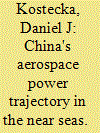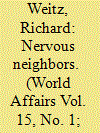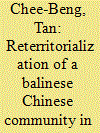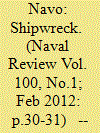| Srl | Item |
| 1 |
ID:
122551


|
|
|
|
|
| Publication |
2012.
|
| Summary/Abstract |
Air and aerospace power has been fundamental for defending China's "near
seas"-encompassing the Bohai Gulf, the Yellow Sea, and the East and South
China Seas-since the founding of the People's Republic.1
While air and naval
operations did not play a significant role in the Chinese Civil War, which was
won by the People's Liberation Army (PLA), the victorious Communist forces
were threatened immediately by hostile air and naval forces from the maritime
sphere. In 1949 the regime was ill equipped to defend its eleven thousand miles
of coastline and more than six thousand islands against attacks and harassment
from Nationalist Chinese air and naval forces occupying the large islands of Taiwan and Hainan, as well as
several smaller islands, let alone protect the People's
Republic of China (PRC) against the aircraft carriers of
the powerful U.S. Seventh Fleet. Even before the People's Republic was officially declared in October 1949,
communist leaders immediately recognized the need
for strong naval and air forces; the PLA's commander,
General Zhu De, stated in April 1949 that China "must
build its own air forces and navy in order to boost
national defense."2
|
|
|
|
|
|
|
|
|
|
|
|
|
|
|
|
| 2 |
ID:
105210


|
|
|
|
|
| Publication |
2011.
|
| Summary/Abstract |
The Chinese central government has identified tourism as an important means of stimulating domestic consumption and transforming China's economic development pattern from investment and export-driven to consumption-led. According to the government's new plan released in 2009, development of Hainan as an International Tourism Destination has been upgraded to a national strategy. By critically discussing the western theories on the policy-making process, this paper intends to adopt the case study of Hainan to specifically analyze its state-initiated plan for regional tourism development. Hainan is the only province in China to clearly be identified by the government for the development of its tourism into a mainstay industry. It is intended to become a test zone for China's tourism reform and innovation and take a lead in development of tourism and associated industries. The government believes that the tourism sector is a key means of boosting regional economic development and reducing regional disparities between Hainan and the prosperous eastern provinces. Nevertheless, Hainan still faces serious obstacles to its goal of becoming a top Asia Pacific holiday destination. A lack of skilled personnel, backward transport network and poor service standards in tourism and hospitality are persistent and pressing issues. The plan for developing Hainan into an international tourism destination is unlikely to become a reality in the near future.
|
|
|
|
|
|
|
|
|
|
|
|
|
|
|
|
| 3 |
ID:
161260


|
|
|
|
|
| Summary/Abstract |
Most analyses of China's foreign and security policies treat China as a unitary actor, assuming a cohesive grand strategy articulated by Beijing. I challenge this conventional wisdom, showing how Chinese provinces can affect the formulation and implementation of foreign policy. This contributes to existing research on the role of subnational actors in China, which has focused on how they shape domestic and economic policies. Using Hainan and Yunnan as case studies, I identify three mechanisms of provincial influence – trailblazing, carpetbagging, and resisting – and illustrate them with examples of key provincial policies. This analysis provides a more nuanced argument than is commonly found in international relations for the motivations behind evolving and increasingly activist Chinese foreign policy. It also has important policy implications for understanding and responding to Chinese behaviour, in the South China Sea and beyond.
|
|
|
|
|
|
|
|
|
|
|
|
|
|
|
|
| 4 |
ID:
103108


|
|
|
| 5 |
ID:
095244


|
|
|
|
|
| Publication |
2010.
|
| Summary/Abstract |
This paper is about a special category of guiqiao or 'returned overseas Chinese', in southern Fujian. Arriving in China from Bali, Indonesia in 1961, the people were settled in an overseas Chinese farm. The paper illustrates how the re-migrants coped with life in China and how they see themselves today. The returned overseas Chinese reterritorize their Indonesian and Balinese cultural life in China, and they, including the local-born children, speak Balinese and eat Indonesian food. Their experiences provide much food for thought on acculturation, migration and identity as well as on the idea of 'homeland'
|
|
|
|
|
|
|
|
|
|
|
|
|
|
|
|
| 6 |
ID:
127250


|
|
|